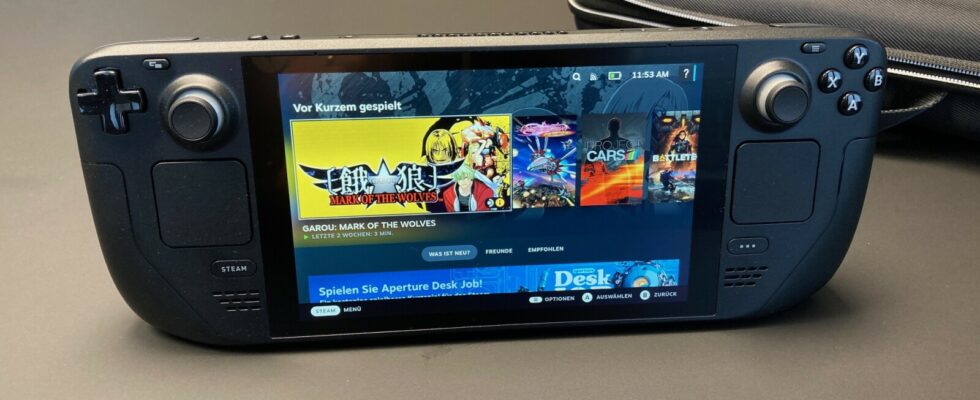Valve now offers the Steam Deck in two versions: Steam Deck LCD and Steam Deck OLED. Our comparison clarifies how the two differ.
Since November 2023, Valve has been offering the Steam Deck, analogous to the Nintendo Switch, in an LCD (from 419 euros) and an OLED version (from 569 euros). Which variant you choose is not just a question of price, because there are also some technical differences to consider.
The following table shows you the most important technical data of the Steam Deck and the Steam Deck OLED in comparison. At first glance it is clear that there are two main differences: the display and the battery life.
| Technical data | Steam Deck OLED | Steam Deck LCD |
|---|---|---|
| CPU | AMD Zen 2 4c/8t, 2.4 to 3.5 GHz | AMD Zen 2 4c/8t, 2.4 to 3.5 GHz |
| GPU | 8 RDNA 2 CUs, 1.0 to 1.6 GHz | 8 RDNA 2 CUs, 1.0 to 1.6 GHz |
| random access memory | 16GB LPDDR5 integrated RAM (6400 MT/s 32-bit quad channel) | 16GB LPDDR5 RAM (5,500 MT/s) |
| Screen | 7.4 inches, AMOLED, 1,280 x 800 pixels, 90 Hz, maximum 1,000 nits | 7 inch, LCD, 1,280 x 800 pixels, 60 Hz, maximum 400 nits |
| Trackpads | 2 x 32.5 mm with haptic feedback | 2 x 32.5 mm with haptic feedback |
| gyroscope | 6-axis IMU | 6-axis IMU |
| Connectivity (Wireless) | Bluetooth 5.3, Wi-Fi 6E | Bluetooth 5.0, WiFi |
| connections | 3.5 jack, DisplayPort, USB-C, microSD | 3.5 jack, DisplayPort, USB-C, microSD |
| operating system | SteamOS 3.0 | SteamOS 3.0 |
| Dimensions | 298mm x 117mm x 49mm | 298mm × 117mm × 49mm |
| Weight | 640 grams | 669 grams |
| Battery life | 3 to 12 hours of gameplay | 2 to 8 hours of gameplay |
| microphone | Yes | Yes |
Steam Deck – Specs
display
While the Steam Deck has an LCD panel, the Steam Deck OLED is equipped with an AMOLED screen. The screen technology offers you richer colors, true black and better contrast. In addition, the Steam Deck OLED now also supports HDR. In short: your games simply look better on the Steam Deck OLED. The screen is slightly larger at 7.4 inches, without increasing the dimensions of the housing.
Unlike the LCD variant, the Steam Deck OLED screen also offers a higher refresh rate. Here you play with up to 90 Hertz. This can be an advantage in competitive games. The brightness of up to 1,000 nits is also significantly higher than the Steam Deck LCD (400 nits). This makes the OLED version more suitable for playing outdoors.
battery pack
AMOLED screens are usually said to have slightly lower power consumption because they can produce a true black by simply turning off the respective pixel. In fact, the Steam Deck OLED also has a longer battery life than the LCD model. However, this is likely to be achieved primarily by increasing the battery capacity (50 instead of 40 watt hours) rather than through the more economical display.
Interesting: Despite the larger battery, the Steam Deck OLED is a few grams lighter than the LCD version.
Storage
Valve sells the Steam Deck OLED in two versions: one has 512 gigabytes of memory, the other 1 terabyte of memory. The LCD model is only available with 256 gigabytes of memory. However, remaining stock of the 64 GB and 512 GB variants will temporarily be available in stores.
Other differences
- the OLED version is equipped with faster RAM.
- The OLED version supports newer wireless standards with Bluetooth 5.3 and WLAN 6E.
- ” Tip: The best VPN providers for more security and data protection
- » Buy balcony power plant: Comparison of the best solar systems
Don’t miss anything with this NETWORK WORLDNewsletter
Every Friday: The most informative and entertaining summary from the world of technology!
